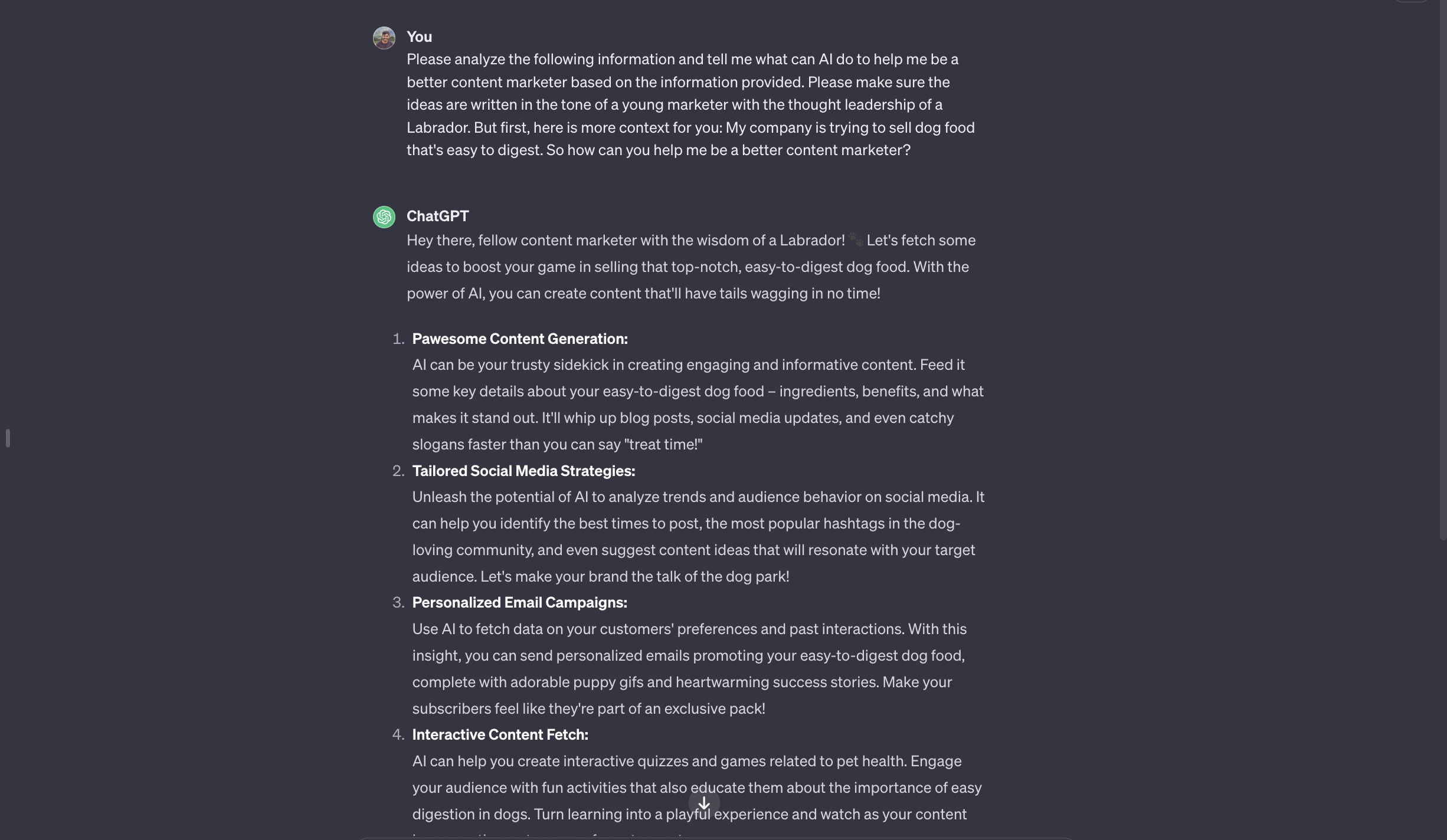Content workflow: Specificity is the secret to creating great campaigns
A content workflow involves a series of tasks performed by a team between the ideation to delivery steps. Here's how it can be a content-compounding machine for your content engine.


I think there’s a reason that the Pepe Silvia scene from It’s Always Sunny in Philadelphia is such an enduring, recognizable piece of popular culture. Even if you’ve never seen It’s Always Sunny, you probably know exactly what I’m talking about: it’s Charlie Day standing in front of a deranged true crime-esque bulletin board, waving his hands frantically while trying to find his way back to the truth.
As content marketers, we feel this scene in our bones. Because even if it’s a distant memory, we’ve worked with a content marketing workflow that leaves us feeling (and even behaving) just like this.
“Can we talk about the content creation process? I’ve been dying to talk to you about the content creation process all day.”

Gif source: Giphy
So, how do you stop waving your hands wildly whenever someone asks you for a status update or for the chance to have input on a piece of content?
A content creation workflow is very often content marketing’s Pepe Silvia. Why? Because like Pepe Silvia, content creation workflows often don’t exist — at least not in a way that helps us create real velocity for our content programs.
In this post, we’re going to run through:
- What is a content workflow?
- Why you need to build more than a content creation workflow
- How (and what) AI tools will help you level up content production in 2024
What is a content creation workflow?
A content workflow involves a series of tasks performed by a team from the ideation to the delivery of a piece of content. It covers the entire content process:
- Outlines all steps for creation (including a space for all your requests)
- Provides space for stakeholders involved
- Adds in required resources and optimization tools for content creation (ideation, proofreading, optimization, etc.)
- Additional instructions/comments
See how our Optimizely Content marketing platform works in this great demo video. You'll get a quick overview on all the features our product offers.
Why marketers need a content workflow
Content creation workflows help you work smarter and get more quality content out the door in less time by creating a repeatable template for the process.
And that’s never been more important. A great Ziflow survey from 2020 found that 52% of marketing teams say any given asset goes through 3-5 rounds of revisions before it goes live. If that sounds light to you, then you’re not alone: 20% of teams said they do 5-10 rounds of revisions.
With so many revisions and stakeholders and an ever-changing editorial calendar, you need to understand where your content is.
When you build and adopt a content workflow, you will:
- Streamline content by ensuring it is consistent and accurate
- Create access to all assets and details for decision-making in one place to not only plan but also identify and manage common bottlenecks
- Meet brand standards every time by adding brand checks directly into the process
- Build a real project management system that stakeholders can rely on and can be measured with real metrics
At Optimizely, we understand the impact firsthand because, of course, we developed content workflows that live within the Optimizely Content Management Platform. We also see how impactful content workflows can be for our customers.
Our customer, BMC Software, recently told our Opticon San Diego audience about the power of building out the right workflows (and tech stack) and how it helped them escape what they described as “the Wild West.”
What are the risks of working without a content workflow?
Working without a content workflow often means working without a repeatable, systematic approach that all your team members can buy into. It may appear to work for a one-person content marketing team, but even when you’re in sole control, you’re still probably dealing with inefficiencies without fully realizing it. These issues grow as your content production or team scales.
What are those obvious and hidden risks?
- Unchecked bottlenecks: Without a workflow, content cascades from team to team in an uncontrolled way. Bottlenecks start to appear in the process because people aren’t aware of their impact on the velocity of the content program, particularly if you have a lengthy approval process.
- Lack of velocity:Do you build a carefully planned editorial calendar and then publish sporadically? Have you ever uploaded five blog posts at the same time, despite starting them five months apart? A lack of workflow means publishing oscillating between a flat-out sprint and twiddling your thumbs. It ultimately slows you down because status, responsibility, and even documents get lost in the shuffle.
- Wasting time and money: So much of the content we produce is time-sensitive, and losing content due to a lack of project management means you’re creating content you can’t use or is no longer relevant, particularly when you create a lot of social media content.
Task-based vs. status-based content workflows: what to choose?
There are two recognized ways of building out content workflows that work for you (not against you): task-based and status-based.
- Task-based workflows: Outline every single relevant step from ideation to analysis and assign it to the person who will complete it. These workflows work best for large teams and complex approval processes.
- Status-based workflows: Use your editorial calendar and assign a defined status to each piece of content. It’s an easy reference guide so everyone understands where a piece of content is and when it’s due to move on. These work well among smaller teams or mature teams who each fully understand their role requirements as it relates to content creation.
How to build a content creation workflow template
What does a content workflow look like in the wild? Most workflows will be customized to the way you and your team members work. To get there, follow these steps.
-
Segment by type
Content flows aren’t a one-size-fits-all exercise. Most teams developed a defined content workflow for different content types.
To keep things simple, create a content workflow for your primary categories of content including:
- Blogs
- Social media posts
- Video
- Podcasts
- Research (e-books, white papers)
- Influencer content
- Case studies
Why do you want different templates? As you move into step 2, you’ll start to unpack the different content approval processes that exist for these content types.
-
Define who does what
Once you know the goals and your audience, define who needs to assist you in terms of project management and at what stage.
For example, the list of stakeholders involved in a typical blog content approval workflow typically includes:
- Marketing manager
- Content strategist
- Content writer/ Copywriter/ Content creator
- Graphic designer
- Social media manager
- SEO specialist
- Web developer
Plus, you also need resources. A content marketing workflow typically includes:
- A content marketing platform (CMP)
- A content management system (CMS)
- Design tools
- Content calendar/ Editorial calendar
- SEO and keyword research tools like clearscope, Ahrefs, etc.
- AI tools for marketing teams (Better, if they’re integrated within the workflow)
Remember that you’ll have different stakeholders for different types of content, so it’s worth building out templates for each type that you regularly produce.
For example, case studies often also require the approval of the marketing teams plus:
- The account manager assigned to the customer
- The customer (point of content)
- The customer’s brand & legal team
You’ll want workflows that reflect the real-world processes that go into making these pieces of content so that you can better manage that project.
-
Write the content brief
A solid content brief template is vital for a content strategy workflow. A campaign brief is a document/note that outlines the goals, objectives, and target audience. Have a clear campaign brief before starting the content management workflow to keep everyone on the team aligned on what they're working towards.
Here are some additional instructions and comments you can add to your brief:
- Keep the new content in line with the brand voice and tone
- Share visual examples for the graphic team to take inspiration from
- Share ideas to repurpose and promote the content on social media and other channels.
-
Set the content creation process.
Think of the content planning steps you need to get quality content out the door faster.
- Ideation: This is where the team does brainstorming and comes up with the initial ideas for the content. They'll brainstorm topics, angles, and formats.
- Research: Once the team has some ideas, it's time to research and validate ideas so the content is accurate and relevant.
- Writing: Now, the team will start writing the content. It may involve multiple writers, depending on the scope of the campaign.
- Design: This step includes creating graphics, images, and video content.
- Proofreading and editing: In this step, the content is reviewed and edited for accuracy, grammar, and style.
- Content publishing: If everything looks good after final approval, the content is published on the website or social media.
- Promoting: Post publishing, content moving happens through promotion. This step may involve social media posts, email marketing, or paid advertising for conversions.
- Measuring: Build performance management directly into your content management workflow. For example, you can add a step to check the traffic and SEO performance of a piece 30 days after publishing.
- Refresh: Do you create a lot of content that’s outdated quickly? Build it into your workflow so that you’re not letting content go stale.
-
Save your workflows. Use automation
Creating similar content using the same process again and again? You don’t have to design a workflow from scratch. You can save a workflow and use it directly in your content marketing platform.
Optimizely’s Content Marketing Platform has a library of marketing workflows that you can use to streamline the types of content you want to create and get started in seconds.
Optimizely is a 8x Leader in CMPs!
How AI can help increase your content velocity in 2024
AI for content: we’re all talking about it.
In addition to helping you level up your content strategy, AI can automate tasks, generate content, and analyze data, all of which can improve the efficiency and effectiveness of content workflows.
 Image source: Chat GPT
Image source: Chat GPT
Here are some examples of what that looks like:
Automating time-consuming tasks
Incorporate AI to take the first pass at tasks that are otherwise time-consuming, like editing. There are AI tools out there to edit blog posts, podcasts, and videos, so that you and your teams can focus on finesse rather than the heavy lifts.
You can also streamline the process of editing against your style guide with the right prompts.
Tools:
- ChatGPT
- Descript (podcast and video editor)
- AI functions in Adobe & Canva
Generating content
AI can help you expand on ideas and quickly produce a long list of alternatives. These tools are particularly helpful for coming up with ideas for titles and headlines.
They’re also great for content repurposing: you can ask your preferred AI tool to turn a piece of content into a summary, a social post, or even a press release.
Tools:
- ChatGPT
- Jasper
- Semrush SEO Writing Assistant
Analyzing data
Feed your data into an AI tool for a quick analysis that you can then validate (or invalidate). You can analyze data about your audience, competitors, and industry with a few quick prompts or even look at your marketing data.
AI tools like the ones below can help you to identify trends, make predictions, improve your content strategy, and even test the salience of your proposed content plan.
Tools:
- ChatGPT
- MarketMuse (content planning software)
- Julius AI (AI data analysis)
- Coefficient (AI data analysis)
Consistent campaign brief
Content creation often slows down due to a poor and inconsistent brief.
You can use AI tools to generate briefs with a few inputs, which takes the leg work out of briefing and frees you up to add the personal touch in a few minutes. Tools:
- ChatGPT
- Jasper
Managing AI in content workflows
Think of AI as your content-compounding machine in the workflow that is capable of delivering high-quality content drafts.
You see, most content production teams know:
- Rewriting old content is tiring
- Thinking of turning old ideas into “new again” is tiring
- Rewriting the same topics repeatedly is tiring
So, start training your AI tool to share some of the workload in the content workflow. Here's how it works.
You do the thinking part:
- Pick a topic
- Find ~5 of your old written content around that topic
- Feed them to the AI tool to 'learn."
- Make sure you don't share anything confidential and face ai ethical issues.
It helps in pattern recognition. The tool understands how you write and the structure you follow. It’s time to instruct the AI bot to write something new. Although AI tools are great at doing, they still need a brief to deliver great content.
So, give the tool and topic and:
- A net new title
- A word-count
- A prompt to follow your writing style that you just trained the tool on
The output is not a finished article but something that does 50-60% of the work. It is where human edits, revisions and creativity come into play. With time, AI will become smart enough to remove this step and give output that is ready to use.
For now, you need to manually edit and turn this draft into a finished content piece. You can:
- Add section titles
- Remove repetitions
- Add the right keywords and questions
- Make edits to ensure everything is easier to read
AI in workflows can give you leverage if you do the thinking part and train the tool on the doing part. The more you write, the more you can repurpose.
Tips for using AI in content workflows
Start small and scale up as you go. Don't try to implement AI in every aspect of your content workflow from the start. We love how the content team at Calendly used a hackathon approach to identify the top tools they wanted to try and started from there.
AI takes time to learn and evolve. Don't expect to see immediate results. Be patient and give AI the time it needs to improve. And remember, AI is not a replacement for your experience, in-depth knowledge, and personality. Use AI to augment your ideas, not replace them.
Prioritize data quality
AI is only as good as the data it's trained on. So, ensure your data is clean, accurate, and secure. It means cleaning up any errors or inconsistencies in your data and protecting it from unauthorized access.
Invest in proper training
AI tools can be powerful, but they can also be complex. That's why invest in training your team on how to use them effectively. Each session should focus on the basics of AI and how to use specific tools to generate content, analyze data, and make predictions.
Monitor and refine AI models
AI models have the functionality to constantly learn and evolve, so continuously monitor their performance. Monitor for errors, identify improvement areas, and retrain the model with new data.
Real workflow results
Content workflows are essential for marketers who want to create and deliver high-quality content that meets the needs of their target audience. By following a well-defined workflow in your content marketing strategy, inefficiencies in the approval process can be removed and a content project can be created and delivered on a fixed timeline.
AI can be a valuable tool for content marketing teams that want to improve the efficiency and effectiveness of their content workflows by automating tasks, generating content, and analyzing data.
With Optimizely, the world's leading digital brands are deploying content workflows to be more agile and drive marketing transformation. Shell is fueling their internal marketing process and seeing success through campaigns created, work requests processed, and assets approved. Check out their story in the above use case of defined content workflows in real time.

